4 weeks, 40+ interviews, 6,000+ photographs: independent journalist Marine Caleb and myself investigated the “Énergie Saguenay” industrial project in Québec (Canada) in September 2019.
Natural gas extracted through fracking in the Alberta province is brought to Montreal via the TC Energy Pipeline. Somewhere along the way, in Ramore (Ontario), a new pipeline could be connected to the existing one. “Gazoduq”, a canadian company, aims to transport the Albertan gas 784 kilometers all the way to Saguenay (Québec), where it would be liquefied in the “Énergie Saguenay” industrial plant. From there, the liquefied natural gas (LNG) would be shipped over to China, Europe and Latin America, supposedly to support the transition from coal to green energy. GNL Québec, the mother company, claims that the whole process could remove up to 80 megatons of CO2 from the atmosphere yearly, thanks to green technology and carbon compensation.
But — there is a but — opponents fear potential pollution in both air, water and soil, risking the existence of wildlife such as the elk or the protected Beluga population of the Saguenay Fjord. Also, they tell us of stories of lobbying (GNL Québec has hired 27 lobbyists), tax evasion (the holding is based in Delaware and many investors are not clean), geopolitics (the biggest investors are Americans close to the Republican Party and China), and colonialism (many First Nations oppose the project).
We documented what we saw, from Montréal to Saguenay to Ramore, driving more than 3,000 kilometers through gold mines, endless forests, lakes and small towns.
Read our articles:
- Krautreporter (Berlin), 24/06/2020: “Wer braucht heute noch eine neue Erdgas-Pipeline?”
- Oil Gas Magazine, December 2019: A new LNG project in Quebec could be the “greenest on Earth” (English): Link to my site
From Montréal to Ramore: 60 photographs

Louis Couillard, Ashley Torres and Léa Ilardo talk after our interview. They are members of the climate collective “La Planète s’invite à l’Université”, which seeks to close the gap between Montreal and “the region” in the opposition against GNL Québec. Montréal, 24/08/2019. 
Interviewed: Caroline Brouillette and Genevieve Puskas from the NGO Equiterre, oppose the GNL Québec project in Montréal. Their ex-founder Steven Guilbeault was elected as a Member of the Canadian Parliament and is Minister of Canadian Heritage under Justin Trudeau. Montréal, 27/08/2019 
Alex Tyrrell, head of the Green Party of Québec, criticized the Canadian Green Party’s as well as the Parti Québécois’ complacency with the industry, and hoped to bring “Énergie Saguenay” to the front of Québec politics during the 2019 election. Montréal, 27/08/2019 
Saguenay-Lac-St-Jean might host the “Energie Saguenay” liquefaction factory and harbour, as well as another industrial harbour complex for Métaux BlackRock and another one for Ariane Phosphate. Yet it is a small town, semi-rural in aspect, nothing like a big industrial city. Chicoutimi, 02/09/2019 
The rolling hills and golden fields of the Saguenay region could soon be crossed through by yet another underground pipeline, bringing natural gas from Alberta (Canada) to the liquefaction plant in Saguenay. La Baie, 03/09/2019 
Ian Segers used to be a staunch climate activist. Today he is a lecturer at the Université du Québec à Chicoutimi in Eco-Counselling programs where he teaches content related to sustainable development ethics. He organizes festivals and co-founded a solidarity cooperative in responsible commerce. For him, companies like GNL Québec are prisonner of their own accounting rationale. Chicoutimi, 04/09/2019 
Many inhabitants of Saguenay-Lac-St-Jean oppose the 3 new industrial projects, or at least one of them. This sign reads “No to a 3d harbour”. Chicoutimi, 03/09/2019 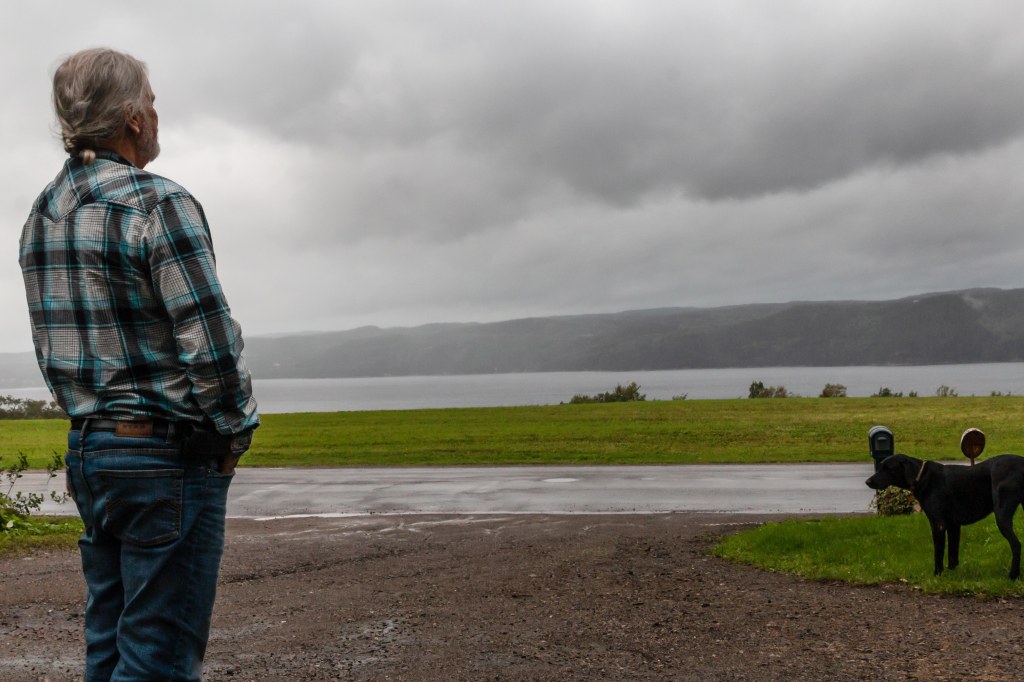
The closest house to the planned Energie Saguenay construction site lies 1km far away. Residents fear pollution through noise, fine particles and construction, but also risks of explosion or tanker accidents in the Fjord. Others say that “progess can’t be stopped”. Chicoutimi, 04/09/2019 
Mayor Josée Néron (r.) and councellor Simon Olivier-Côté (l.) at a townhall meeting. The latter was one of the few councellors to oppose the construction of Énergie Saguenay, whilst the former encourages the industrial development of her town. Chicoutimi, 03/09/2019 
This building in the commercial area of Chicoutimi is the official headquarters of GNL Québec… yet no sign indicates the offices. Chicoutimi, 04/09/2019 
Sunset in a typical street of a peripheric neighborhood of Chicoutimi, known for its tranquility. Chicoutimi, 04/09/2019 
A fountain represents the endangered Beluga population which finds itself at home between the Saguenay Fjord and the St-Laurent estuary. These whales represent the region and attracts many tourists, yet they the three new industrial projects endanger them even further: water and noise pollution, collision with the tankers, risks of gas leaks represent a risk for the species. Chicoutimi, 05/09/2019 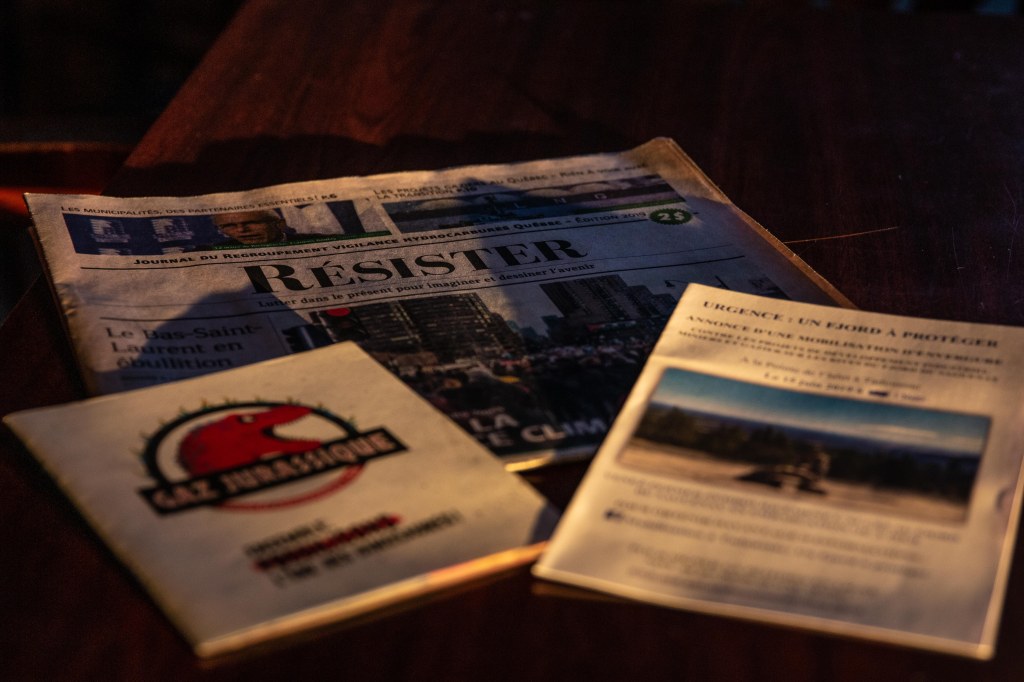
“Resist”, reads one of these militant brochures; “Jurassic Gas” jokes the other, all givent to read at a meeting of the Coalition Fjord. Chicoutimi, 05/09/2019 
Rodrigue Turgeon, former head of the “Gazoduq Parlons-en” collective in Rouyn-Noranda, has come all the way to Saguenay to discuss on which strategies to use to oppose GNL Québec. Alliances have been formed by activist groupes in the whole Province against the LNG project, sometimes including First Nations. Chicoutimi, 05/09/2019 
Adrien Guibert-Barthez, co-founder of the “Coalition Fjord” organisation, leads the strategic meeting in a micro-brewery of Chicoutimi. The Coalition has organized many actions and protests, including a kayak demonstration. Chicoutimi 05/09/2019 
A member of the “Coalition Fjord” shares his mind on which strategy is best for the big Climate March planned on Sept. 27th: oppose specifically GNL Québec, or climate change in general ? Chicoutimi, 05/09/2019 
The debate rages on between members of the “Coalition Fjord”. Chicoutimi, 05/09/2019 
The Saguenay Fjord is a major tourist attraction as a well as a natural shrine, known for its green forests and deep blue waters. Yet, this is where three new industrial harbours could be built. Saguenay Fjord, 06/09/2019 
The already existing infrastructure of the industrial port of the Grande Anse, as seen from the other side of the Fjord. For now, maritime activity is relatively low, and comprises mostly touristic cruisers. Saguenay Fjord, 06/09/2019 
Kayak, sailing ships and cruise vessels could soon navigate next to huge gas tankers – up to 200 yearly. Employees from the Cap Jaseux Resort fear that the industrialization will threaten tourism. Saguenay Fjord, 06/09/2019 
The Grande Anse industrial port complex as seen from the Cap Jaseux Resort. This is where the Énergie Saguenay liquefaction plant and the Metaux BlackRock harbour would be built. Saguenay Fjord, 06/09/2019 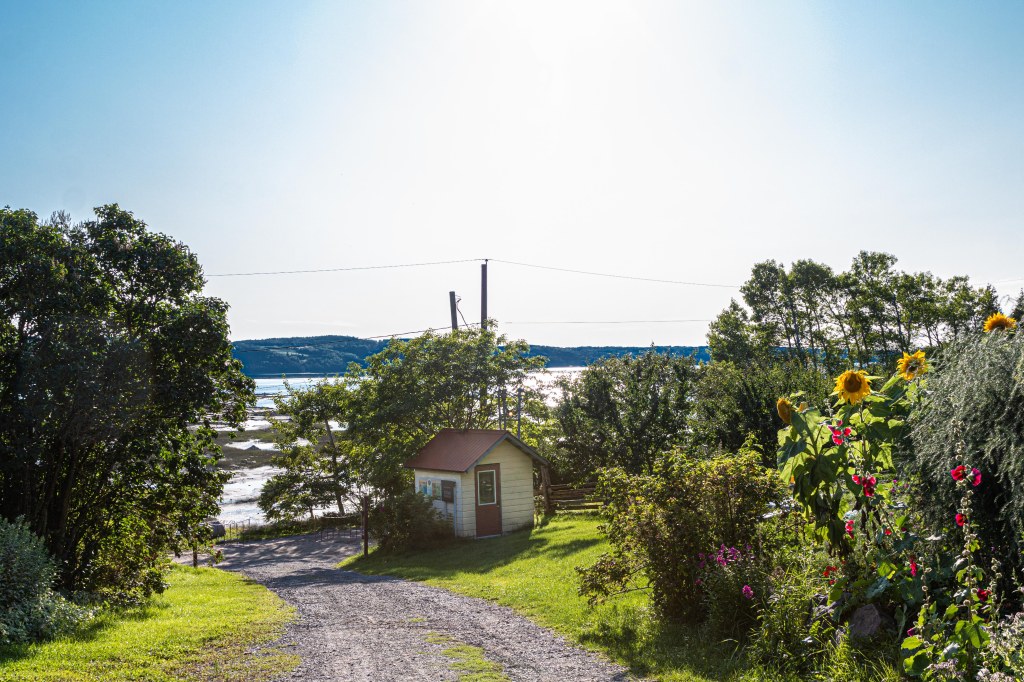
This auto-sufficient farm sells fresh cabage and meals, and even welcomes guests in its Bed and Breakfast. This small paradise could soon have a view on huge LNG installations. Saguenay Fjord, 06/09/2019 
The Gazoduq pipeline could possibly come very close to this dairy farm. The farmer explained that Gazoduq employees tried to convince him to sell some of his land in order to build the pipeline, but that he had resorted to the powerful Union of Agricultural Producers (UPA) before deciding. Lac-St-Jean, 07/09/2019 
In Chibougameau, one of the northernmost towns of Québec province, timber is one of the most important industries, next to mining. The endless forests are eroded at a growing rate to satisfy industrial needs. This situation is the same everywhere in the province. Chibougameau, 08/09/2019 
The road to Amos, in the region of Rouyn-Noranda, is endless. It passes forests, fields, First Nations “Reservations”, and finally houses where miners invest all of their enormous revenue (mostly in cars, trucks, alcohol and drugs). Amos, 08/09/2019 
Gazoduq is GNL Québec’s subsidiary company in charge with building the pipeline. In its April 2019 planned route, the company tried to avoid most cities and natural parcs, but still met with resistance. Amos, 10/09/2019 
Olivier Pitre, from the Abitibi-Témiscamingue Groundwater Society (SESAT), explains that the planned pipeline route comes close to community water sources and to eskers, gigantic ice formations where many towns get their water from, potentially representing a threat for drinking water quality. Amos, 10/09/2019 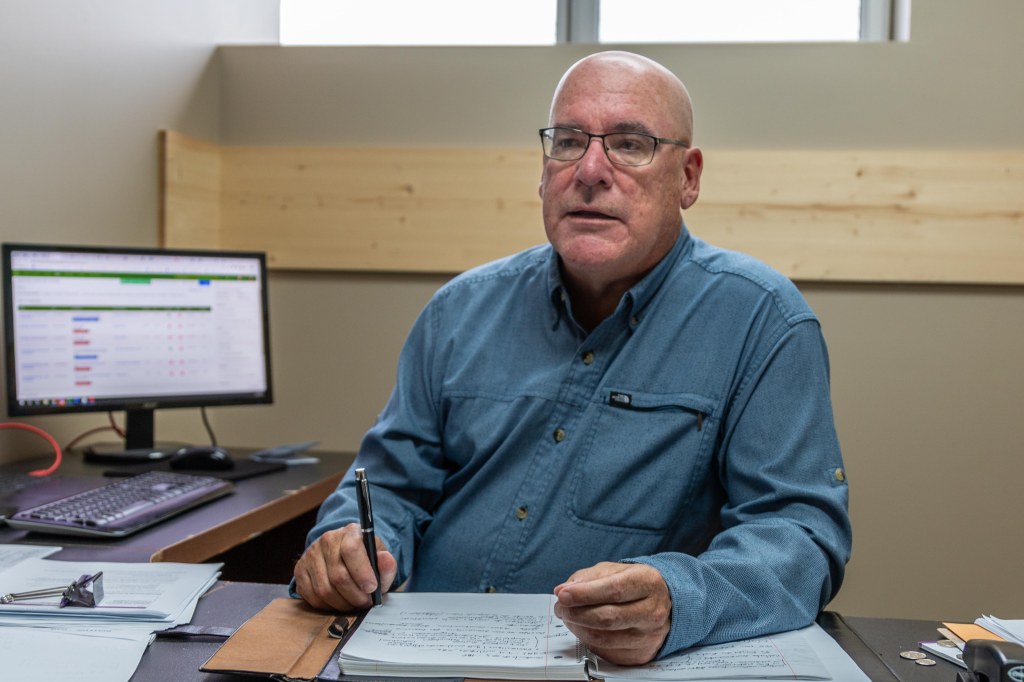
Claude Balleux is the head of the Chamber of Commerce and Industry of Amos. As most people in the Abitibi-Témiscamingue region, he had to clear opinion on the Gazoduq project due to a lack of information. Amos, 10/09/2019 
A sandpit on the Saint-Mathieu-Berry esker. Amos, 10/09/2019 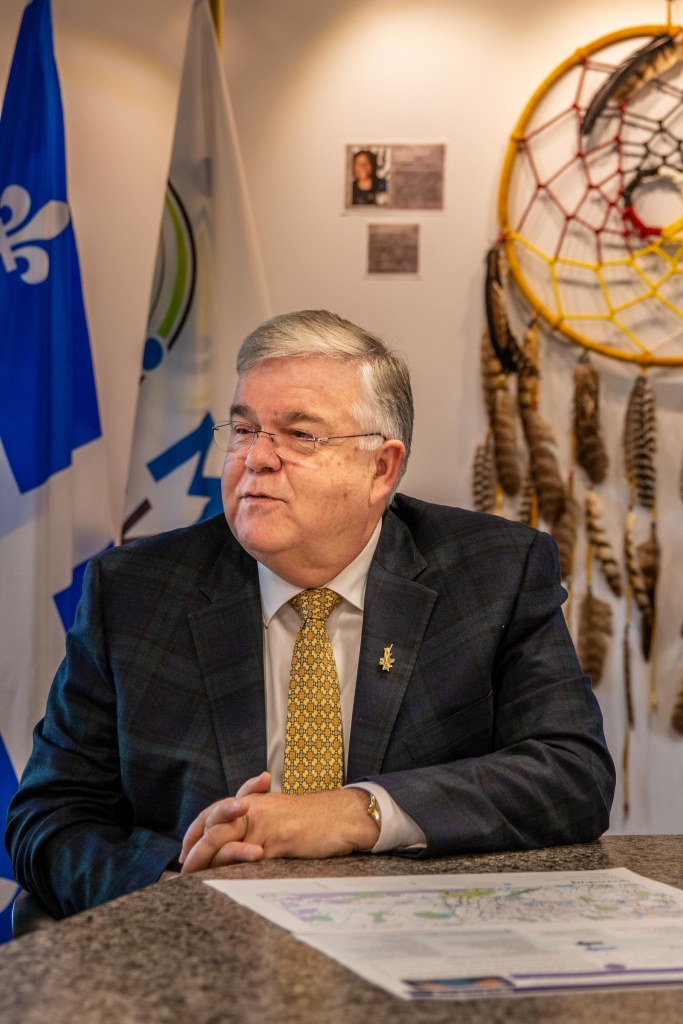
Pierre Corbeil, at the time was president of the Regional county municipality and mayor of Val d’Or, also former minister under the Québec Liberal Party. He assures that Gazoduq have a constructive and open position, and that natural gas is a transitional energy source. Val d’Or, 11/09/2019 
Lucien Wabanonik is councellor at the Band Council of the Anishnabe Nation of Lac Simon, close to Val d’Or. He defends his community’s right to oppose the pipeline, if necessary, by any means available to them. He also explained how the living conditions in a “reservation” are catastrophical. Lac Simon, 11/09/2019 
Many First Nations have been forced to turn to Christianity. Today, both animist and christian faiths live next to each other. Drugs, alcohol, weapons, material poverty and exclusion as well as ecocide have been other sides of White colonialism. Lac Simon, 11/09/2019 
Even though legally still regulated by the “Indian Law” of 1876, First Nations today have few in common with the “Indian” stereotype: most live in poor, semi-urban communities with modern comfort, only… without the comfort. Lac Simon, 11/09/2019 
Andrew Sheer, candidate for the 2019 Canadian federal election, makes a speech on TV attacking Justin Trudeau and also staunchly advocating for the oil & gas industry. He even proposed an “energy corridor” stretching through Canada from east to west. Inside a small typical restaurant close to Lac Simon, 11/09/2019 
A statue honors the mine workers of Rouyn-Noranda, a town built to accomodate the mining industry. Rouyn-Noranda, 11/09/2019 
Members of the Coalition Anti-Pipeline in Rouyn-Noranda meet inside a microbrewery for a group interview. They have a long history of opposing other industrial projects, such as mines — a new lithium mine is planned not far away for electric batteries. Rouyn-Noranda, 12/09/2019 
Clémentine Cornille and Jacinthe Châteauvert (on the phone) from the Regional Council of the Environment of Abitibi-Téminscamingue (CREAT) explain which dangers the pipeline would bring to the fauna and flora of the region, including the wetlands and elks. Rouyn-Noranda, 13/09/2019 
Joel Godard poses in front of his pick-up truck (a necessity on the dirt tracks of his region), where a “Stop Gazoduq”-sticker is affixed. Behind him, a teepee stands on the community’s land in D’Alembert. Rouyn-Noranda, 13/09/2019 
Joel Godard is the chief of the Mi’k-Mak and Métis community of Rouyn-Noranda. Not officially recognized as a First Nation, they are descendants of Mi’k-Mak (from the other end of the Québec province) and of white settlers who were settled here in the 1930’s. Rouyn-Noranda, 13/09/2019 
Gazoduq’s pipeline could possibly run on the other side of the lake, through the affluent river and the forests where Joel hunts, fishes and picks wild berries. Rouyn-Noranda, 13/09/2019 
Joel Godard eats what his hands can get him: fish from the lake, elk from the forest and berries from the bush, all frozen for the winter to come. Her fears that the growing industrialization of the region threatens this way of life, especially his quasi-spiritual relationship with the elk. Rouyn-Noranda, 13/09/2019 
The compressor station 105 in Ramore (Ontario) is where the Gazoduq pipeline could start, before running 784km all the way to Saguenay. Ramore, 13/09/2019 
The Gazoduq pipeline might look like TC Energy’s underground pipeline in Ramore: a 30-m highway where no tree can grow, and where wildlife is vulnerable to predators. Ramore, 13/09/2019 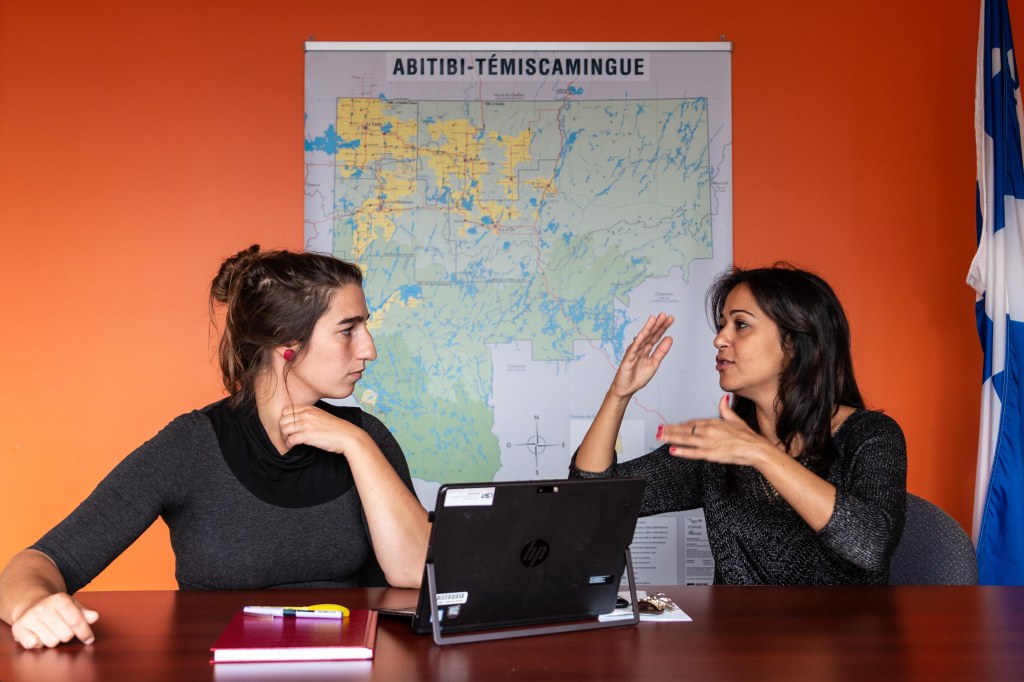
Émilise Lessard-Therrien and Ruba Ghazal, both Members of Parliament of Québec Solidaire, a leftist party, also oppose the GNL Québec project and the unecological position of both the federal and the provincial governments. Rouyn-Noranda, 14/09/2019 
Signs reading “Thou Shall not Pass” greet activists coming to demonstrate against the Gazoduq pipeline. Rouyn-Noranda, 14/09/2019 
Two members of the Regroupement Vigilance Mines de l’Abitibi-Témiscamingue (REVIMAT) at the protest against Gazoduq. Rouyn-Noranda, 14/09/2019 
A child holds a sign reading “The future lies in the water” during a demonstration against Gazoduq. Rouyn-Noranda, 14/09/2019 
Mother and daugther perform together during a demonstration against Gazoduq. Rouyn-Noranda, 14/09/2019 
A crowd of climate activists, scientists and politicians (including Emilise Lessard-Terrien and Ruba Ghazal from Québec Solidaire) cheer during a rally against Gazoduq. Rouyn-Noranda, 14/09/2019 
Louis Couillard and Ashley Torres from “La Planète s’Invite” and Nicolas Ouellet, a pro-climate lawyer, chant together at a rally against Gazoduq. Rouyn-Noranda, 14/09/2019 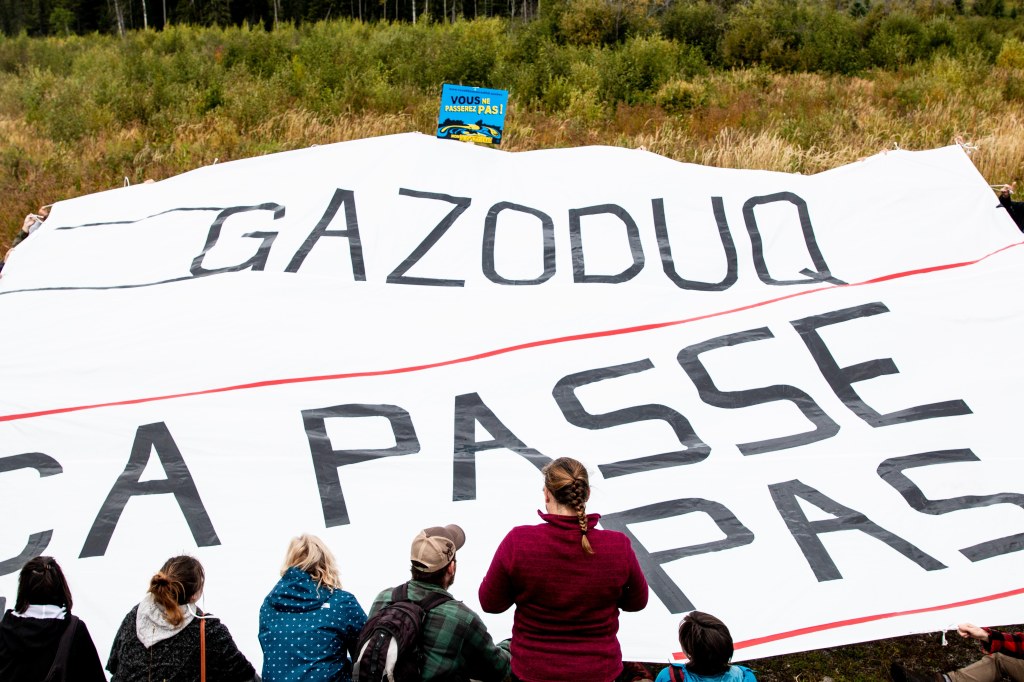
A group of protesters unfurl a banner reading “Gazoduq Cannot Pass” during a demonstration against the pipeline project at the border between Ontario and Québec, where the pipeline is planned to pass. Rouyn-Noranda, 14/09/2019 
Protesters from various climate organizations, also including First Nation members, chant and sing during a demonstration against Gazoduq, on the border between Ontario and Québec. Their signs read “No to Gazoduq” and “Thou Shall Not Pass”. Rouyn-Noranda, 14/09/2019 
Schoolbuses bring the protestors back to town after a demonstration against Gazoduq at the border between Ontario and Québec. Rouyn-Noranda, 14/09/2019 
Wetlands are important for biodiversity and climate regulation, and are home to hundreds of animal species. Many activists and scientists fear that the Gazoduq pipeline may harm these lands. Rouyn-Noranda, 14/09/2019 
The Canadian Malartic gold mine is one of the biggest in Canada and in the world. The whole town of Malartic was moved so that more gold could be excavated, This mine represents the industrialization and colonization in the Québec province. Malartic, 15/09/2019 
An elk rests in the Pageot wildlife shelter. Elks are a symbol of Indigenous and White climate activism in the region. Amos, 15/09/2019 
Normand Mousseau is a theoretical physicist and academic director of the Trottier Energy Institute, based at Polytechnique Montréal. He is passionate about sodium batteries and believes that energy transitions are a great opportunity to rethink urban planning and the development of our societies. Montréal, 16/09/2019 
Geneviève Paul from the Québec Center for Environmental Law (CQDE) explains the legal details behind the GNL Québec project and it’s opposition. The CQDE pledges for the safeguard of environmental norms and helps climate activists when arrested. Montréal, 16/09/2019 
Eric Tétrault is the president of the Energy Association of Québec (formerly the Oil & Gas Association of Québec). He advocates for the development of the oil & gas industry in Québec, which relies mostly on hydraulic energy from the numerous dams in the province. He believes that GNL Québec’s project makes sense globally. Montréal, 18/09/2019 
Eric Notebart, an emergency physician and clinician-researcher, is studying the health risks associated with hydraulic fracturing. He organized a tour of climate scientists in Quebec to raise awareness in the region. Montréal, 18/09/2019 
3,000 kilometers in total, 2 weeks and 6,000 pictures: our investigation took us from Montréal to Chibougameau to Amos to Val d’Or to Rouyn-Noranda to Ontario, as close as the roads enabled us to get to the pipeline route (in black). (Google maps screen capture)
